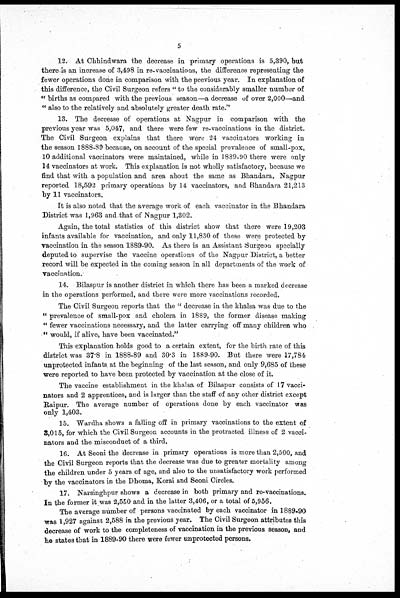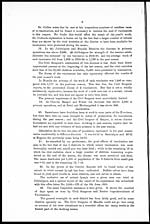Medicine - Vaccination > 1868-1929 - Report on the vaccine operations in the Central Provinces > Vaccine operations Central Provinces 1886-1899 > 1889-1890 - Report on the vaccine operations in the Central Provinces for the year 1889-90
(161) Page 5
Download files
Individual page:
Thumbnail gallery: Grid view | List view

5
12. At Chhindwara the decrease in primary operations is 5,390, but
there is an increase of 3,498 in re-vaccinations, the difference representing the
fewer operations done in comparison with the previous year. In explanation of
this difference, the Civil Surgeon refers " to the considerably smaller number of
" births as compared with the previous season—a decrease of over 2,000—and
" also to the relatively and absolutely greater death rate."
13. The decrease of operations at Nagpur in comparison with the
previous year was 5,047, and there were few re-vaccinations in the district.
The Civil Surgeon explains that there were 24 vaccinators working in
the season 1888-89 because, on account of the special prevalence of small-pox,
10 additional vaccinators were maintained, while in 1889-90 there were only
14 vaccinators at work. This explanation is not wholly satisfactory, because we
find that with a population and area about the same as Bhandara, Nagpur
reported 18,592 primary operations by 14 vaccinators, and Bhandara 21,213
by 11 vaccinators.
It is also noted that the average work of each vaccinator in the Bhandara
District was 1,963 and that of Nagpur 1,302.
Again, the total statistics of this district show that there were 19,203
infants available for vaccination, and only 11,830 of these were protected by
vaccination in the season 1889-90. As there is an Assistant Surgeon specially
deputed to supervise the vaccine operations of the Nagpur District, a better
record will be expected in the coming season in all departments of the work of
vaccination.
14. Bilaspur is another district in which there has been a marked decrease
in the operations performed, and there were more vaccinations recorded.
The Civil Surgeon reports that the " decrease in the khalsa was due to the
" prevalence of small-pox and cholera in 1889, the former disease making
" fewer vaccinations necessary, and the latter carrying off many children who
" would, if alive, have been vaccinated."
This explanation holds good to a certain extent, for the birth rate of this
district was 37.8 in 1888-89 and 30.3 in 1889-90. But there were 17,784
unprotected infants at the beginning of the last season, and only 9,685 of these
were reported to have been protected by vaccination at the close of it.
The vaccine establishment in the khalsa of Bilaspur consists of 17 vacci-
nators and 2 apprentices, and is larger than the staff of any other district except
Raipur. The average number of operations done by each vaccinator was
only 1,403.
15. Wardha shows a falling off in primary vaccinations to the extent of
3,015, for which the Civil Surgeon accounts in the protracted illness of 2 vacci-
nators and the misconduct of a third.
16. At Seoni the decrease in primary operations is more than 2,500, and
the Civil Surgeon reports that the decrease was due to greater mortality among
the children under 5 years of age, and also to the unsatisfactory work performed
by the vaccinators in the Dhoma, Korai and Seoni Circles.
17. Narsinghpur shows a decrease in both primary and re-vaccinations.
In the former it was 2,550 and in the latter 3,406, or a total of 5,956.
The average number of persons vaccinated by each vaccinator in 1889-90
was 1,927 against 2,588 in the previous year. The Civil Surgeon attributes this
decrease of work to the completeness of vaccination in the previous season, and
he states that in 1889-90 there were fewer unprotected persons.
Set display mode to: Large image | Zoom image | Transcription
Images and transcriptions on this page, including medium image downloads, may be used under the Creative Commons Attribution 4.0 International Licence unless otherwise stated. ![]()
| Permanent URL | https://digital.nls.uk/91428557 |
|---|
| Attribution and copyright: |
|
|---|




